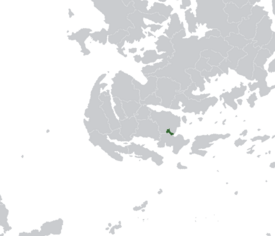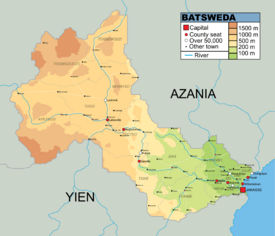Batsweda: Difference between revisions
| Line 108: | Line 108: | ||
* Between 1505 and 1517, with the growing frequency of Orinese attacks on Yien, an emboldened Banno Salamic merchant class in Old Jakasse successfully rebel against the central authority, with the revolt extending to the rest of the Tsweda river basin. In 1517, Koseda I declares himself Kã́á ("king") of the Batsweda Empire, a large multi-ethnic entity focused on the production and exportation of gold and spices. | * Between 1505 and 1517, with the growing frequency of Orinese attacks on Yien, an emboldened Banno Salamic merchant class in Old Jakasse successfully rebel against the central authority, with the revolt extending to the rest of the Tsweda river basin. In 1517, Koseda I declares himself Kã́á ("king") of the Batsweda Empire, a large multi-ethnic entity focused on the production and exportation of gold and spices. | ||
=== | ===Batswedan Empire=== | ||
===Pepper Coast Company rule=== | ===Pepper Coast Company rule=== | ||
===Independence and civil wars=== | ===Independence and civil wars=== | ||
Revision as of 13:29, 28 September 2024
Republic of Batsweda | |
|---|---|
| Anthem: "O, Dawn of Liberty" | |
 Location of Batsweda (dark green) | |
 Map of Batsweda | |
| Capital and largest city | Jakasse |
| Official languages | Anglish, Sahrabic |
| Recognised national languages | Banno, Latso, Mi, Nitnide |
| Ethnic groups (2020) | 34.3% Banno 22.8% Latso 19.9% Nitnide 14.5% Mi 6.4% Sahrab 2.1% Other |
| Religion (2020) | 51.9% Salam 38.1% Christianity 5.2% Traditional faiths 3.3% no religion 1.5% Other |
| Demonym(s) | Batswedan |
| Government | Unitary parliamentary directorial republic under a military junta |
| Dialla Sacko (interim) John Obuor (interim) | |
| Samuel Nyantah (interim) | |
| Legislature | Parliament |
| Senate | |
| National Assembly | |
| Independence from the Pepper Coast Company | |
• Conquest of the Tsweda river basin | c. 1500 |
• Siege of Jakasse | 12 May 1811 |
• Independence declared | 11 November 1960 |
• Joined the Assembled Nations | 1 January 1961 |
• End of the First Batsweda Civil War | 12 February 1969 |
| 27 September 2002 | |
| Area | |
• Total | 33,550 km2 (12,950 sq mi) |
• Water (%) | 14.2 |
| Population | |
• 2020 census | 1,214,380 |
• Density | 36.2/km2 (93.8/sq mi) |
| GDP (PPP) | 2024 estimate |
• Total | $4.062 billion |
• Per capita | $3,345 |
| GDP (nominal) | 2024 estimate |
• Total | $1.475 billion |
• Per capita | $1,215 |
| Gini (2024) | medium |
| Currency | Batswedan gerah (₲) (BDG) |
| Time zone | UTC+7 (Central Europan Time) |
| Driving side | left |
| Calling code | +360 |
| ISO 3166 code | BD |
| Internet TLD | .bd |
Batsweda[1], officially the Republic of Batsweda[2], is a country on the southeastern coast of Azania on Eurth. Bordered by Yien to its south and the Konstantinopoli Sea to the east,
Etymology
The Anglish name for the state, Batsweda, comes from the Banno endonym for the region, Ɓɛ́xwáɖá, meaning "the pepper forest" or "the pepper bush" (ɓɛ́-nì xwáɖá), referring to the region's heavily forested environment and its notable cultivation of peppers and other spices. This name was first seen in the 16th century Sahrabic tome A Guide to the Southern Lands of Azania, in mentioning the Batsweda Empire. The Sahrabic name for the country, āl-Bahūda (البهودة), was also first mentioned within this work.
The Pepper Coast, an alternative name used by Anglish speakers for the region since the mid-17th century, was popularized by the Pepper Coast Company after its colonization of modern-day Batsweda's coast in the early 19th century. This name soon became the official name of the territory, and remained so until 1960, when the Batswedan War of Independence ended in decolonization, with the newly independent government officially renaming the state Batsweda in its first constitution.
Geography
Climate
Ecology
History
Antiquity
- By 750 BCE, the earliest signs of human habitation in modern-day Batsweda are seen.
- The Banno people enter the region around 500 BCE, forming sedetary communities based on farming and livestock.
- The fortified settlement of Old Jakasse is founded in the 2nd century BCE, and power in centralized into a local semi-urbanized kingdom.
Kingdom of Jakasse
- By the 1st century BCE, the Kingdom of Jakasse expands throughout the Tsweda river basin, forming an economy based on the exportation of spices, dyes, and gold to the rest of Azania and Europa, especially the Aroman Empire.
- The Latso and Mi peoples settle in the kingdom by the 2nd century CE, employed and metalworkers and pastoralists in the state's northern periphery.
- Pushed on its southern border by the expanding Sarafid Empire, the Kingdom of Jakasse is invaded and conquered by the Sarafids in 416 CE, bringing the region under the influence of its southern neighbour.
Middle Ages
- Under Sarafid rule, the region of modern-day Batsweda is positioned as a periphery province of the empire, with Old Jakasse entering into a period of economic decline. By the 700s CE however, Old Jakasse re-establishes itself as a major trading port.
- In 756 CE, with the collapse of the Sarafid Empire, various fortified settlements and tribes within the Tsweda river basin assert their independence. These small city-states, chief among them Old Jakasse, Sena, and Kpaba, emerge as notable centres of trade, namely around the exchange of gold and spices.
- By 1100, Sahrabic merchants and scholars position themselves within the gold trade, founded the Old Jakasse Madrassa and, by the 1300s, successfully convertimg the Batswaden coast to Salam, with Old Jakasse becoming a notable centre of Sahrab-Banno cultural exchange and learning.
- In 1225, Old Jakasse is besieged and the Bastwedan coast annexed by Yien. Around the same time, the Latso people in the region's north unite into the Latso Kingdom in 1229.
- Between 1505 and 1517, with the growing frequency of Orinese attacks on Yien, an emboldened Banno Salamic merchant class in Old Jakasse successfully rebel against the central authority, with the revolt extending to the rest of the Tsweda river basin. In 1517, Koseda I declares himself Kã́á ("king") of the Batsweda Empire, a large multi-ethnic entity focused on the production and exportation of gold and spices.
Batswedan Empire
Pepper Coast Company rule
Independence and civil wars
Post-Jakasse Peace Accords
Politics
Government
Administrative divisions
| District | County seat | Population | Area km2 | Density km2 | Map |
|---|---|---|---|---|---|
| Bewatso County | Latsoville | 75,582 | 2,318 km2 | 32.6/km2 | Template:Batsweda labelled map |
| Do County | Sekona | 102,460 | 302 km2 | 339.3/km2 | |
| Dogbo County | Niarma | 33,885 | 1,557 km2 | 21.8/km2 | |
| Honme County | Nicholls | 44,947 | 2,540 km2 | 17.7/km2 | |
| Jakasse County | Jakasse | 404,938 | 67 km2 | 6,043.9/km2 | |
| Kpetsosi County | Nsango | 22,633 | 5,821 km2 | 3.9/km2 | |
| Nidya County | Sehe | 51,723 | 756 km2 | 68.4/km2 | |
| Sika County | Kpaba | 49,026 | 3,754 km2 | 13.1/km2 | |
| Suuf County | Payar | 87,455 | 215 km2 | 406.8/km2 | |
| Todzi County | Boshibi | 38,440 | 3,364 km2 | 11.4/km2 | |
| Togbedzudzo County | Apakwai | 19,242 | 4,348 km2 | 4.4/km2 | |
| Togbewodzi County | Lashina | 17,434 | 2,530 km2 | 6.9/km2 | |
| Tsotso County | Begochiman | 83,636 | 3,291 km2 | 25.4/km2 | |
| Tswe County | Danolle | 62,208 | 2,412 km2 | 25.8/km2 | |
| Zimi County | Williamstown | 120,771 | 275 km2 | 439.2/km2 | |
| Batsweda | Jakasse | 1,214,380 | 33,550 km2 | 36.2/km2 |

